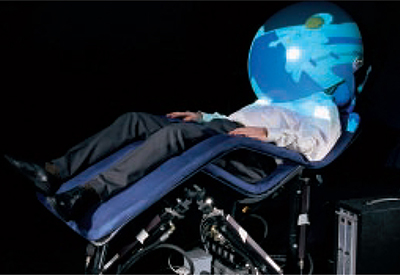Wrap-around Worlds
Cyberspace will never be the same. Vision, sound, vibration, and motion cuing come together to offer a sensory extravaganza—a personal encounter with virtual space.
Flogiston Corporation of Austin, Texas has designed a reclining relaxation chair, replete with a wrap-around, bubble dome display built into the head of the chair and a projector, as well as delivery systems for sight, sound, and motion. The result? A sensation of floating in space.
The product was fostered by a NASA Small Business Innovation Research (SBIR) contract managed by the Johnson Space Center. This NASA spinoff was first developed for astronauts as a virtual workstation, a space-like classroom to hone spacewalking skills. The chair incorporates research gained by NASA in designing spacecraft that carry human passengers, as well as data on the natural position a body assumes when floating in the microgravity of space. Using this posture information, Flogiston's patented reclining chair provides a minimal stress environment for a person interfacing with computer and electronic systems for extended periods.
The two-foot diameter dome offers the chair's occupant a complete field of view of virtual space. This projected cyberspace image wraps around the head of the participant, occupying the person's peripheral vision. Visuals are augmented by high-quality, surround sound speakers mounted inside the dome.
Shakers are built into the chair to provide whole body vibration, with higher-end chair models having enhanced vibration abilities. Mounted on a three- or six-axis motion platform, a generic motion simulator for simulated digital environments is created. Movements by the chair are synchronized with the operator's motion cuing actions inside the digital world. Left and right hand controllers are mounted on the arms of the chair. These hand controllers can serve several functions, such as navigating in space, or manipulation of objects in three-dimensional space.
Real-time video or recorded media can be accommodated, as can computer graphics, involving active or passive interaction. State-of-the-art audio and video hardware is utilized giving the chair's user a totally immersed—eyes, ears, body, and hands—virtual experience.
Flogiston president and design engineer, Brian Park, explains that a wide array of commercial applications for the full immersion chair are foreseen. Applications include entertainment, educational training, and stress management, even as the ultimate travel brochure for the prospective vacationer.
Motorola recently purchased one of the firm's basic models for testing and demonstrating new image warping technology they are developing, Park says. Intel, the computer chip manufacturer, has also purchased a chair for demonstrating immersion.
Demonstrations of chair models at medical, computer, and electronic trade shows have been well received, Park reports. Health community specialists saw the device as a tool for treatment of phobias, pre-operative education of patients, and as a workstation of the future for surgeons.
Numbers of chairs can also be operated in tandem, depending on computing resources available. Doing so can yield a shared immersion of a team that must collectively work together while performing individual tasks, or for networked gaming on the Internet. Clearly, the entertainment and education value of the chair for theme parks, be it real-time viewing of the Earth from space, undersea exploration, or flying over the terrain of a distant planet, is a targeted user community.
If immersive cyberspace is to be the natural method of computer interaction in the next century, Park says that his creation "is a significant step towards providing an effective and useful form of immersion for everyone." A low-cost, entry-level model of the chair without a motion base is being developed for home use, Park reports.
Given that there are no head-mounted displays to wear, no gloves, no cables, no huge shared screen, Park says that his new form of immersion in virtual and video space offers a personal view of cyberspace. "It's the best seat in the house," he says.

Instead of cumbersome head-mounted displays or gloves, the Flostation consists of a relaxation chair with a bubble dome display built into the head of the chair. The participant reclines in the neutral posture similar to astronauts floating in zero gravity.













